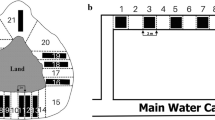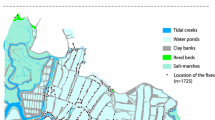Abstract
The water opossum Chironectes minimus is the world’s only semi-aquatic marsupial. It is considered rare, and it is reported on several regional conservation lists of species as either endangered or data deficient. Given its uniqueness and the poor knowledge of its ecology, we aimed to investigate home range size and overlap and habitat selection of the water opossum in Atlantic Forest streams in southeastern Brazil. We radio tracked water opossums and collected information about their habitats and behaviour from October 2004 to April 2010. We combined common home range estimators for animals living in linear habitats with the synoptic model of home range and habitat selection. For the 10 individuals monitored, the home ranges varied between 0.80 and 9.66 km of watercourses; none of them had exclusive home ranges. The home range size for males was, on average, three times larger than for females. The overlap data showed that, on average, one male could encompass the home ranges of up to five females simultaneously, but more than one male could have access to the same female. For habitat selection at the individual level, we could not find any strong influence of habitat features on water opossum preferences because individuals selected different sets of habitat variables. However, at the population level, we found a negative relationship between home range size and river size. The water opossum seems to prefer shallow and narrow watercourses to establish its home ranges. Here, we present valuable information to advance our knowledge of the water opossum and its ecology, which is urgent for conservation purposes.
Similar content being viewed by others
References
Adler, G. H., 2011. Spacing patterns and social mating systems of echimyid rodents. J. Mammal. 92, 31–38.
Arnold, T.W., 2010. Uninformative parameters and model selection using Akaike’s information criterion. J. Wildl. Manage. 74, 1175–1178.
Bates, D., Mächler, M., Bolker, B., Walker, S., 2015. Fitting linear mixed-effects models using (lme4). J. Stat. Softw. 67, 1–48.
Blundell, G.M., Maier, J.A.K., Debevec, E.M., 2001. Linear home hanges: effects of smoothing, sample size, and autocorrelation on kernel estimates. Ecol. Monogr. 71, 469–489.
Bressiani, V.B., Graipel, M.E., 2008. Comparacão de metodos para captura da cuíca d’água Chironectes minimus (Zimmerman, 1780) (Mammalia, Didelphidae), no sul do Brasil. Mastozool. Neotrop. 15, 33–39.
Burnham, K., Anderson, D., 2002. Model Selection and Multimodel Inference: a Practical Information-theoretic Approach, 2nd edn. Springer-Verlag, New York. Calenge, C, 2006. The package “adehabitat” for the R software: a tool for the analysis of space and habitat use by animals. Ecol. Modell. 7, 516–519.
Chiarello, A.G., Aguilar, L.M.D.S., Cerqueira, R., de Melo, F.R., Rodrigues, F.H.G., da Silva, V.M.F., 2008. Mamíferos Ameacados de Extincão no Brasil. In: Machado, A.B.M., Drummond, G.M., Paglia, A.P. (Eds.), Livro Vermelho da Fauna Brasileira Ameacada de Extincão, vol. II. MMA—Ministério do Meio Ambiente, Brasília.
Clutton-Brock, T.H., 1989. Mammalian mating systems. Proc. R. Soc. 236, 339–372.
Leite, M.S., Galliez, M., Queiroz, T.L., Fernandez, F.A.S., 2016. Data from: spatial ecology of the water opossum Chironectes minimus in Atlantic forest streams.
Movebank Data Repos., https://doi.org/10.5441/001/1.4rr97k10.
Emlen, S.T., Oring, L.W., 1977. Ecology sexual selection, and the evolution of mating systems. Science 197, 215–223.
Fernandez, F.A.S., Galliez, M., Leite, M.S., Queiroz, T.L., Palmeirim, A.F., 2015. Natural history of the water opossum Chironectes minimus: a review. Oecol. Aust. 19, 47–62.
Fisher, D.O., Owens, I.P.F., 2000. Female home range size and the evolution of social organization in macropod marsupials. J. Anim. Ecol. 69, 1083–1098.
Fisher, D.O., Owens, I.P.F., Johnson, C.N., 2001. The ecological basis of life history variation in marsupials. Ecology 82, 3531–3540.
Galliez, M., Fernandez, F.A.S., 2012. Spatial segregation between the water opossum Chironectes minimus and the water rat Nectomys squamipes: just competition avoidance or a conservation problem as well? Mamm. Biol. 77, 447–450.
Galliez, M., Leite, M.S., Queiroz, T.L., Fernandez, F.A.S., 2009. Ecology of the water opossum Chironectes minimus in Atlantic forest streams of southeastern Brazil. J. Mammal. 90, 93–103.
Horne, J., Craig, T., Joly, K., Stout, G., Cebrian, M., Garton, E., 2014. Population characteristics, space use and habitat selection of two non-migratory caribou herds in central Alaska, 1994–2009. Rangifer 34, 1–20.
Horne,J.S., Garton, E.O., Rachlow, J.L., 2008. A synoptic model of animal space use: simultaneous estimation of home range, habitat selection, and inter/intra-specific relationships. Ecol. Modell. 214, 338–348.
Johnson, D., 1980. The comparison of usage and availability measurements for evaluating resource preference. Ecology 71, 65–71.
Leite, M.S., Galliez, M., Queiroz, T.L., Lima, D.O., Cid, B., Pinho, G., Fernandez, F., Caramaschi, E., 2009. O gambá d’água como espécie guarda-chuva para a conservacão da fauna associada a rios de Mata Atlântica/RJ Technical Report., Available at: https://doi.org/www.fundacaogrupoboticario.org.br/pt/o-que-fazemos/editais/pages/apoio-projetos-detalhes.aspx?identificador=0750_20071.
Marshall, L, 1978. Chironectes minimus. Mamm. Species 109, 1–6.
Mattisson, J., Sand, H., Wabakken, P., Gervasi, V., Liberg, O., Linnell, J.D.C., Rauset, G.R., Pedersen, H.C., 2013. Home range size variation in a recovering wolf population: evaluating the effect of environmental, demographic, and social factors. Oecologia 173, 813–825.
McClintic, L.F., Taylor, J.D., Jones, J.C., Singleton, R.D., Wang, G., 2014. Effects of spatiotemporal resource heterogeneity on home range size of American beaver. J. Zool. 293, 134–141.
Ostfeld, R.S., 1990. The ecology of territoriality in small mammals. Trends Ecol. Evol. 5, 411–415.
Palmeirim, A.F., Leite, M.S., Santos-Reis, M., Fernandez, F.A.S., 2014. Habitat selection for resting sites by the water opossum (Chironectes minimus) in the Brazilian Atlantic Forest. Stud. Neotrop. Fauna Environ. 49, 231–238.
Powell, R.A., Mitchell, M.S., 2012. What is a home range? J. Mammal. 93, 948–958.
Pulliam, H.R., Danielson, B.J., 1991. Sources, sinks, and habitat selection—a landscape perspective on population-dynamics. Am. Nat. 137, S50–S66.
Quaglietta, L, Fonseca, V.C., Mira, A., Boitani, L, 2014. Sociospatial organization of a solitary carnivore, the Eurasian otter (Lutra lutra). J. Mammal. 95, 140–150.
R Core Team, 2015. A Language and Environment for Statistical Computing. R Foundation for Statistical Computing, Vienna, Austria.
Ribeiro, M.C., Metzger, J.P., Martensen, A.C., Ponzoni, F.J., Hirota, M.M., 2009. The Brazilian Atlantic forest: how much is left, and how is the remaining forest distributed? Implications for conservation. Biol. Conserv. 142, 1141–1153.
Sauer, T.M., Ben-David, M., Bowyer, R., 1999. A new application of the adaptive-kernel method. Estimating linear home ranges of river otters, Lutra canadensis. Can. Field-Nat. 113, 419–424.
Slaght, J.C., Horne,J.S., Surmach, S.G., Gutiérrez, R.J., 2013. Home range and resource selection by animals constrained by linear habitat features: an example of Blakiston’s fish owl. J. Appl. Ecol. 50, 1350–1357.
Somers, M.J., Nel, J.A.J., 2004. Movement patterns and home range of Cape clawless otters (Aonyx capensis), affected by high food density patches. J. Zool. 262, 91–98.
Tucker, M.A., Ord, T.J., Rogers, T.L., 2014. Evolutionary predictors of mammalian home range size: body mass, diet and the environment. Glob. Ecol. Biogeogr. 23, 1105–1114.
Vanak, A.T., Gompper, M.E., 2010. Multi-scale resource selection and spatial ecology of the Indian fox in a human-dominated dry grassland ecosystem. J. Zool. 281, 140–148.
White, G., Garrot, R., 1990. Analysis of Wildlife Radiotracking Data. Academic Press, San Diego.
Author information
Authors and Affiliations
Corresponding author
Rights and permissions
About this article
Cite this article
Leite, M., Galliez, M., Queiroz, T.L. et al. Spatial ecology of the water opossum Chironectes minimus in Atlantic Forest streams. Mamm Biol 81, 480–487 (2016). https://doi.org/10.1016/j.mambio.2016.05.003
Received:
Accepted:
Published:
Issue Date:
DOI: https://doi.org/10.1016/j.mambio.2016.05.003




